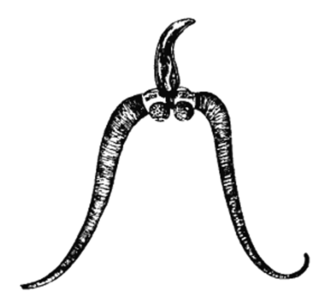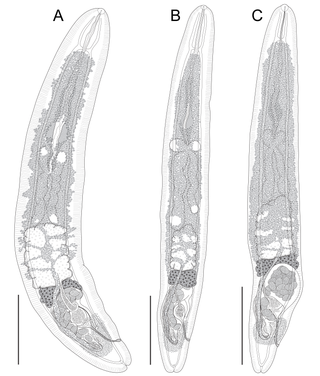
Bucephalidae is a family of trematodes that parasitize fish. They lack suckers, having instead a muscular organ called a "rhynchus" at the front end which they use to attach to their hosts. The characteristics of the rhynchus are used to help define the genera of the family. It is one of the largest digenean families, with 25 genera containing hundreds of described species. Bucephalids are cosmopolitan, having been recorded all over the world. They are parasites of fish from freshwater, marine, and brackish water habitat types.

Opecoelidae is a family of trematodes. It is the largest digenean family with over 90 genera and nearly 900 species, almost solely found in marine and freshwater teleost fishes. It was considered by Bray et al. to belong in the superfamily Opecoeloidea Ozaki, 1925 or the Brachycladioidea Odhner, 1905.

Hamacreadium is a genus of trematodes in the family Opecoelidae. It is synonymous with Olivacreadium Bilqees, 1976. Species of Hamacreadium are endoparasitic in fish such as Lethrinus Cuvier, 1829.
Allopodocotyle is a genus of trematodes in the family Opecoelidae.
Cainocreadium is a genus of trematodes in the family Opecoelidae. It has been synonymised with Apopodocotyle Pritchard, 1966, Cainocreadoides Nagaty, 1956, and Emmettrema Caballero y Caballero, 1946.
Coitocaecum is a genus of trematodes in the family Opecoelidae. It has been synonymised to Ozakia Wisniewski, 1934, Paradactylostomum Zhukov, 1972 nec Toman, 1992, and Pseudocoitocaecum Bilqees, 1972.
Neolebouria is a genus of trematodes in the family Opecoelidae.
Peracreadium is a genus of trematodes in the family Opecoelidae. It is very similar to the related genus Cainocreadium Nicoll, 1909, and has been synonymised with the genera Anabathycreadium Salman & Srivastava, 1990, Indocreadium Salman & Srivastava, 1990, and Lebouria Nicoll, 1909.
Podocotyloides is a genus of trematodes in the family Opecoelidae.
Transversotrema is a genus of trematodes in the family Transversotrematidae.
Helicometrinae is a subfamily of trematodes in the family Opecoelidae.
Aephnidiogenidae is a family of trematodes in the order Plagiorchiida.

Aporocotylidae is a family of trematodes within the order Diplostomida, which contains species commonly known as fish blood flukes. It contains more than 40 genera, the largest being Cardicola. Species in this family parasite fish in both fresh and marine water.

Lepocreadiidae is a family of trematodes in the order Plagiorchiida.

Lepotrema amansis is a species of lepocreadiid digenean parasitic in the intestine of marine fish. It was described in 2018.

Lepotrema amblyglyphidodonis is a species of lepocreadiid digenean parasitic in the intestine of marine fish. It was described in 2018.

Lepotrema hemitaurichthydis is a species of lepocreadiid digenean parasitic in the intestine of marine fish. It was described in 2018.

Lepotrema justinei is a species of lepocreadiid digenean parasitic in the intestine of marine fish. It was described in 2018. This species was not characterised by molecular means but was distinguished from other species of the genus Lepotrema by morphological characteristics. It is the only species with more or less symmetrical testes, and, probably as a result, it tends to be broader than the other species.
Parallelolebes is a genus of trematodes in the family Opecoelidae.
Pseudoheterolebes is a genus of trematodes in the family Opecoelidae. After having been originally described, it was largely ignored by other scientists due to the originally vague definition of the genus; Martin et al., 2018 resurrected the genus to resolve a dispute among the existing definitions of Opistholebes and Maculifer, which were also described by earlier reports of Yamaguti.







